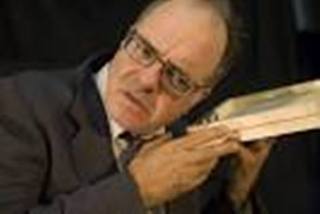|
Back
Silent Snow, Somnolent Snow New York
Miller Theater, Columbia University
10/10/2015 -
John Luther Adams: In The White Silence (New York premiere)
JACK Quartet: Christopher Otto, Ari Streisfield (Violins), John Pickford Richards (Viola), Kevin McFarland (Cello); International Contemporary Ensemble (ICE), Steven Schick (Conductor)

J. L. Adams (© BMI)
Call it a hunch, a vague idea, an un-educated guess, But I have a feeling that John Luther Adams is not exactly in the foreground when it comes exploring oil resources from his adopted Alaska home. The lanky Mississippi-born composer loves his adopted state far too much.
Not that Mr. Adams is against exploiting Alaska’s resources, not at all. In his career, he has mined the silences, the seas, the snows, the mountains, the very air of Alaska for several decades now. He has extracted his spirits and emotions from the land and water, he has committed those feelings into reality through the refineries of his own mind. In the process, he has turned Nature into Notes, the spirit of the land into an equally amorphous spirit of music.
Mr. Luther confesses that he is not part of the compositional “mainstream.” But this is not politics, and the “outriders” are the successful ones. So he is partly Reich and the other John Adams, partly Glass, his durations are Feldman-length, his orchestral invention comes from Harry Partch, and his love of nature goes back to the earliest American hymnals, even Edward MacDowell.
And while he was relatively ignored until recently, John Luther Adams was honored with the 2015 William Schuman Awards this week, celebrated over three concerts in Miller Theater. I heard the final one last night. And while not regretting attendance, I would not repeat the experience. In The White Silence was, to say the least, problematical. Not to participants, perhaps, but to this listener.
Some say that Mr. Adams’ music is best heard recorded, since one can be alone, thinking one’s own thoughts, meditating and (shhhhh!) stopping the music to pour a stiff whiskey. Others feel only a live performance can achieve the colors which he needs for success.
My only other live performances was the Pulitzer Prize-winning Become Ocean, and I was mesmerized because I could put a face to the music. Whatever his goal, this was Ocean! I felt the rumbling and vibrations and dimensions and the essence, and I loved it.
Last night’s In The White Silence was a different kettle of non-fish, non-ocean. First, it was metaphysically/spiritually abstract, and one had to gear up for idealism. Second, the title is a metaphorical impossibility. Silence may be golden or it may be white, but silence is not celesta, harp, string quartet, two vibraphones, strings and enthusiastic conductor.
True, one can take the conductor’s own words, that In The White Silence is “an open and uncluttered soundscape...soloists play against the backdrop of the smooth mirrored surface of an ensemble of strings...the nuances of consonance...man-made art within the great spaces of the natural world.”
Yet Miller Theater, spacey enough, is not the natural world. And regretfully, this 90-odd minutes of uninterrupted slow (lugubriously slow) soft (whispery soft) murmurings from harp and celesta (the same eight-note theme over and over again), from the occasional backgrounds of strings and vibraphones (in which even a double-bass player couldn’t resist a yawn) and the friendly solos of the JACK Quartet, my mind drifted elsewhere.
This was not Mr. Adams’ fault. But perhaps one needed hours of meditation before the concert. And that wasn’t possible in New York. At home, I had a sick dog going on hunger strike. Walking to the subway, the East Village on this balmy Saturday night, was packed with raucous merry-makers. Under the streets, the New York subway system had broken down, and I had to run from transport to transport before huffing and puffing and finally sitting down, as the ensemble walked solemnly on stage.
In this case, I needed music that would grab my earlobes and take me to places unknown.
This was not the case of In The White Silence. This was music meant to soothe or mesmerize, not to show the way. Also, it was never challenging music. Mr. Adams’ vocabulary is simple, non-dissonant, non-arrhythmic, non-daring.
Whatever his forebears, nobody dares mention the one composer who he most resembles: Alan Hovhannes. That same reverence for nature, those same delicate harp/celesta, sounds, ambiguously exotic (not modal or Asian), those same repetitions.
Dedicated to his mother, Mr. Luther’s work treads through the endless wastes (the Arctic?) carefully, subtly, with endless metaphorical shades of white, bound by a few leitmotifs. The major motif is a slow eight-note upward arpeggio on the harp, deftly harmonized, repeated and intertwined with celesta. Over the 90 minutes, it appears several times in each section, not quite the same each time but hardly transformed.
We had the changes in texture as well. Like a concerto grosso, the strings of International Contemporary Ensemble (ICE) with vibraphone, produced a background of sounds, while the various soloists played above it.
The major soloists being here the JACK Quartet. In one truly beautiful section, First Chair Christopher Otto played a ravishing theme, which was taken up fugally with the rest of the group before the music went back into its lulling background. At that point, my mind wandered back to the sadly neglected Schoenberg String Quartet Concerto, equally tonal, but with the impetus to actually go somewhere.
Here, though, we had sustained chords, tremolos, soft vibraphone notes and again that harp/celesta arpeggio. All suspended in space, not a dissonant harmony to be heard...
The audience was, I confess, seemingly entranced. Nobody looked at watches (I don’t have a watch, but probably would have resisted). Nobody looked terribly bored. Everybody respected these changes of tonal colors, these faux climaxes before the start of the next movement (The piece had 19 sections, from “Beginning” to “Letter B...Letter S”).
Endless...vast...white.
The title of Conrad Aiken’s story is “Silent Snow Secret Snow”. Aiken, though, was writing about oncoming madness. I wasn’t going insane. But frankly, I coulda used the buzzing of, maybe, a small oil drill to punctuate this maddeningly unpunctuated music.

S. Schick (© Mark Palmer)
These are, however, the best musicians in New York, and they played with all the dedication necessary under the hands of Steven Schick.
Mr. Schick is possibly more famous as a percussionist (and excellent writer) than as a conductor. And here, his percussion was mainly vibraphone, played very softly. Presumably, his leadership was good. But it reminded me of an interview I once had with a very famous conductor. When questioned about any composer he didn’t want to conduct, he immediately said “Philip Glass.”
Adding, “Oh, I love Glass’s music. But as a conductor, all I can do is beat time and cue in the instruments. Not much fun.”
Mr. Schick did that, and doubtless he could reveal other secrets to make the score go. But as a listener, those secrets were buried under the silent, sometime sonorous and more often somnolent slumbrous (zzzzz) snows.
***********************
CODA: While an error of fact (or judgment) is as rare in these columns as a chorus of kazoos in a Requiem Mass, it does happen. For last week’s review of the New York Philharmonic’s Gala Opening, I wrote that Magnus Lindberg was “last year’s composer-in-residence.” Mr. Lindberg did hold that position but it was 2009-2011, followed by Christopher Rouse and this year’s honor going to the second Finnish composer, Esa-Pekka Salonen. My apologies.
Harry Rolnick
|